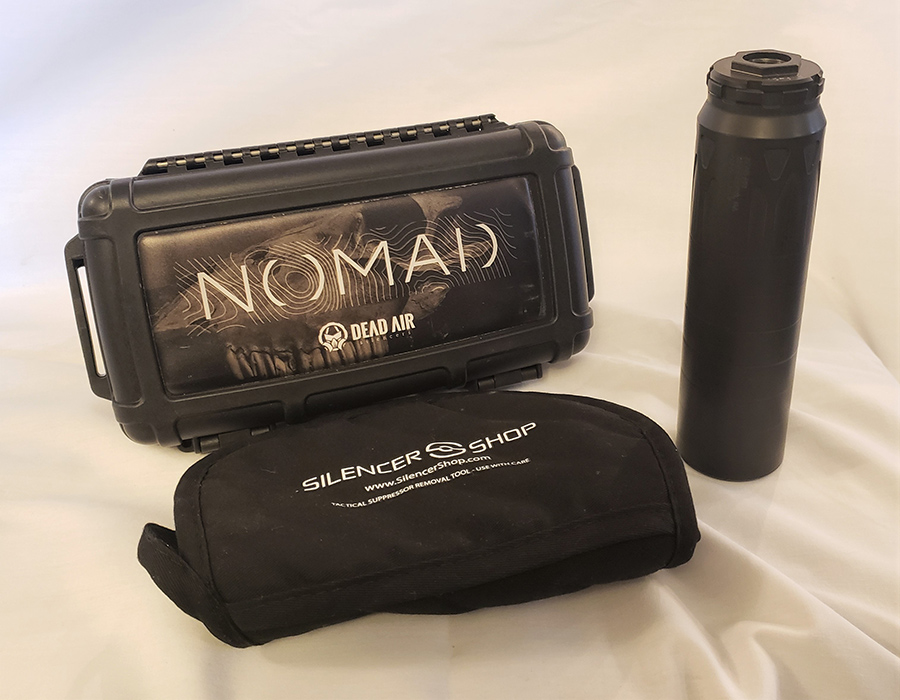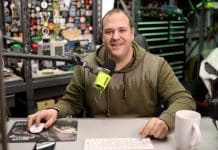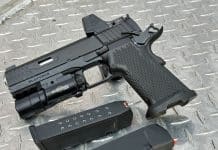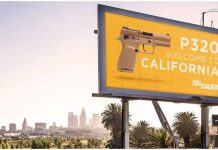
A suppressor is a tool, just like a gun. There are many myths and beliefs about these tools that are common misconceptions. Check out a previous article I wrote, Protect Your Hearing! The Facts and Myths of Suppressors. Suppressors are NFA-regulated items, so there is a good deal more to getting one than your everyday firearm. That being said, there are several online companies that help significantly with this daunting task. Once you’ve acquired your suppressor, there are some considerations that will need to take place to achieve your end goal.
2020 was a tough year for everyone. This is a certainty. However, even the worse hardships can be turned into a blessing with some hard work and patience. While my Concealed Handgun Class was shut down for several months due to state-mandated quarantine, my other job was going strong. This allowed me to survive the hardships financially. When the first round of government stimulus checks came out, I was able to spend it on myself. I decided it was time to delve into the world of NFA and get myself a suppressor. After all, what is more American than using my government stimulus check to get a suppressor? My most immediate firearm that would be capable of accepting a suppressor was my Savage Model 10 in .308. So, a .30 caliber suppressor was the obvious choice. Now, which one?
Making the purchase
I knew a small amount about suppressors at this stage—a few bigger names and how they worked. I also knew the suppressor (or “can” as they are sometimes referred to) would drastically change the trajectory of the round fired and cause a lot more fouling to be blown back into any action. It had been over a decade since I learned these things, which meant a re-education was in order. Like many other markets in the firearms industry, there had been many changes. A major change would be cost. Over ten years ago, a quality “can” would cost thousands, and anything under $1,000 would not last. Manufacturing production and changes means the cost goes down, which in turn means the price goes down. Now you can get quality for under $1,000 and, depending on the caliber and style you desire, around the $500 mark. I was looking at getting everything for $1,000 total (including all the fees) and getting a versatile “can” that would work on multiple platforms. As with any firearm decision, be sure you know what you want because there are no returns. I did online research, spoke with several knowledgeable people, and went to a few local gun stores that had the product on hand.
Ultimately, I decided on a Dead Air Nomad .30. Dead Air is a quality manufacturer out of Georgia, with a great reputation and a Lifetime Warranty. These cans are well machined and versatile. The list of calibers compatible with the Nomad .30 is long and covers everything from a .22 Hornet to a .300 Ultra Mag. The decibel reduction is best with .30 caliber rounds but not as good with the smaller calibers. There are cone and baffle mods that can increase the effectiveness with smaller calibers. It comes ready to be directly threaded to the barrel along with a nice hard case for storage and a glove to handle the hot can after shooting. You can add an aftermarket QD muzzle brake and Key Mo collar that turns the can into a QD system for your favorite ARs, should you choose to do so. It is also full-auto rated for those with a better supply of ammo than I currently possess.

When it came to making my purchase, I had heard the horror stories but also the triumphs. I had decided the most effective long-term way to ensure my suppressor was legally possessed would be to set up a living trust, the Form 4 Tax Stamp. Not only was this my preferred way of filing the forms, but also the trust could be used to protect my other assets in the event I pass away. This protected my possessions from probate court so that my wife or daughter could obtain possession of what I leave behind. A responsible way of protecting my assets for my family, in my opinion. As many know, a legal government form can be a pain to understand and complete. Help is usually needed. There are several companies that can aid in these steps. I decided on the Silencer Shop. Not only did the process go smoothly, but I also saved some money. The retail price on the Nomad .30 is $969, but through Silencer Shop, I was able to get it for $745 at the time. This did not include tax and fees, but a savings of $224 helped cover those. With the tax stamp and the trust, it came out to $1,080, which was a touch over budget but very doable.
One of the reasons I went through Silencer Shop was they have local dealers that they work with, which means local people get a cut of the profits. I like to support local businesses, and this was the best of both worlds, easy one-stop-shop with electronic filing, and my local guys earned a bit as well. I first contacted Silencer Shop to get some questions answered and found out that their “Gold” Dealers have a kiosk that makes things even easier. My closest was about an hour away but very good to work with and knowledgeable when I went to visit. I put my order online in April of 2020 and was given a year lead time. I had to be patient at that stage and wait. Now I’ve heard that going through these bigger name dealers helps streamline the process since there are usually no mistakes to slow the process down. I can’t say for sure that this is the case, but I can say five months later, the suppressor was in my hands. I was happily shocked when I got the call and made the hour trip a few days later when time allowed. I took my .308 with me to get an idea of how well it fit. It was a thing of beauty if I do say so myself.

.308 Range Time – Pros and Cons

Range time with the can was interesting. As expected, I had to re-sight the rifle in. By adding a good amount of length to the end of your barrel, the bullet has a different pressure curve when leaving the barrel, plus more dwell time to increase velocity. This meant a tact driving rifle, like mine, had to be re-sighted in. The first problem I experience was barrel fouling. The .308 had been shot quite a bit and was broken in, but the grouping would open up after about 15 or 20 shots. I had heard of this happening but wasn’t prepared for it. I also heard about the can getting hot and causing issues, so I was careful to let things cool between every 2 or 3 shots. The Nomad is made of Titanium, and stainless steel, which meant cool down didn’t take long at all. Maybe a minute would pass, and it was ready to shoot again. Usually, I’d take that time to walk to my target for a closer look before continuing. You could also tell that back pressure caused more to be blown back into the receiver, even on a bolt action, but nothing to cause stoppage. It took about 30 rounds to get sub-MOA groups at 100 yards with my rifle, and we were back in business. I tested a shot or two at 150 yards and 191 yards to be sure my hold over reticle worked, and from a steady rest, I was able to hit a 9″ plate in the vital zones with every shot. I don’t usually shoot this distance, so I believe that with some practice, I could get better grouping. Until then, I’m confident that I can make an ethical shot at that distance should the need arise.




One of the reasons for a suppressor on my .308 was to help out a friend with disabilities shoot this rifle during deer season from a rest while sitting in his wheelchair. The rifle was already an easy shooter, but the recoil reduction was a huge surprise. It made this .30 tact driver into a pussycat, with the recoil being comparable to a good AR in 5.56. It was amazing. As far as sound suppression, I can tell you I couldn’t be happier. I wrote in a previous article that suppressors made good neighbors. It will be quiet enough that I could take a shot at a coyote at night and not wake the family or neighbors. While I haven’t shot a coyote yet, I can tell you my neighbor can barely tell when I’m shooting this rifle. Hearing protection is, of course, always recommended, but I love shooting this gun without them. The sound reduction is down to the point that I can hear the round hit the cardboard on the target, and when I shoot filled water jugs, I hear them explode (I never realized how loud they were before now because the rifle sound muffled it).

Another concern about suppressors is weight. This particular setup is a 20″ fluted heavy barrel on a Savage AccuStock. It’s a pretty hefty setup in its own right. The weight was a concern. The Nomad is lightweight at 14 oz and 6.5″ long. It is a bit awkward in a tight tree stand, but in the 2-man box stand I built and at the range, it is a breeze. Enough to notice, but very manageable. My buddy in the wheelchair was very appreciative of the box blind I built for him, taking him on his first hunt ever and setting him up on a solid rifle he could handle without any issues. Of course, now he wants my rifle and suppressor to find their way into his closet, but that won’t happen. Hopefully, next year we’ll get him a deer.


.300 Blackout – Pros and Cons

My next gun to put the suppressor on was an AR, which I built in .300 Blackout. With a semi-auto, suppressors can be even more problematic. With this build, I decided to use the Adams Arms Piston system, and I highly recommend it. The problems don’t fully go away, but with a piston system, the issues are manageable, and the gun keeps working. As far as the suppressor and this build on the range, there were again some issues that are part of using a suppressor. The first was the action got a lot more blowback from the chamber. I own another piston AR and love how clean everything is after shooting. There was a lot more blowback with the suppressor. It is just going to happen. You are pushing a lot of gases back by adding a can, and it has to go somewhere. Keeping the blowback down to an amount that allows the gun to keep running and out of the shooter’s face is the biggest concern. With this build, you can do just that.


Accuracy was again an issue that had to be addressed. The issue of the barrel fouling quickly was more evident in the AR. My guess is that it is 2-fold. First, with it being a semi-auto, the chamber seal is broken as the round exits opening even more blowback down the barrel and out the chamber. With bolt action, everything stays closed until you manually cycle the action. When that happens, a lot of smoke comes out, but the gun powder stays put. The second is this was a new barrel, and I learned quickly that it needed to be broken in. After getting a .30 caliber Bore Snake, life got better. This is exactly what the tool was made for, and a quick pass after about five rounds was all that was needed to tighten the grouping right back to its expected accuracy. After learning this and spending some quality time on the trigger, this rifle and barrel were getting MOA accuracy at 100 yards with several shots touching. While the grouping opened up quite a bit and needed to be babied, it was only in terms of the precision I was trying to achieve. If you are looking at hitting a 10″ piece of steel or paper target every time, your expectations won’t be disappointed. As a hunter, I was asking more from my gun and not expecting long shooting sessions with it.


As far as sound suppression goes, the .300 didn’t disappoint with subsonic ammo. The sound reduction was so much that shooting steel almost seemed pointless since the steel ringing got loud. The gun was everything you’d expect out of a suppressed AR. Another surprise was the pop you’d hear with supersonic rounds. It was noticeably louder than the .308 (which I have not used any subsonic rounds with). My guess is since the AR has a 16″ barrel versus the 20″ barrel .308, the extra 4″ makes the difference. I could be way off, but that’s just my educated guess. One last aspect is recoil reduction. My goal was to build a viable deer rifle for my skinny 10-year-old daughter to shoot comfortably. With subsonic ammo and the suppressor, she was able to gain enough courage and confidence to hit the target at 100 yards. She did say she felt a push but, when prompted, she admitted no pain. It just felt weird to her. Rest assured, I’m working with her to build those tolerances up, but I don’t want to push too hard and take the fun out of it.

Conclusion

Overall, I couldn’t be happier with my purchase. Once I was educated on the idiosyncrasies of a suppressor and had these rifles dialed in with it, I won’t go back. It is just too much fun to take the headphones off, have that light recoil and hear the rounds hit the target. If you haven’t gotten one yet and are thinking about it, I’d recommend it sooner rather than later. The price of the can itself has gone up and is currently selling on the same website for $819. Also, the NFA office has been flooded even more than before, and it will take a long time to get your paperwork through. Go ahead and start the wait now. I got the can with the plans of building the .300 while I waited. My plans didn’t quite work out but pretty darn close. I finished my build the month following, taking possession of the can. My opinions of the Dead Air Nomad? Amazing, and I’d recommend it to anyone and everyone. It exceeded my expectations and is exceptionally well made and versatile. I can’t wait to put it on a few more rifles just because I can. Suppressors aren’t evil, and there is an advantage to them. If you are in the market, look at Dead Air and do your research. You’ll be happy you did. After all, “silence is golden,” and a good suppressor is worth its weight in gold.

Want more posts like this one? Subscribe to Guns & Tactics to receive email updates and special offers direct to your inbox!
Social Links:
– The views and opinions expressed on this web site are solely those of the original authors and contributors. These views and opinions do not necessarily represent those of Guns & Tactics, the administrative staff, and/or any/all contributors to this site.
– Affiliate Disclaimer: Guns and Tactics is reader/viewer supported. This post may contain affiliate links and we may earn a small commission when you click on the links at no additional cost to you. As an Amazon Affiliate I earn from qualifying purchases.













i add a suppressor to an airsoft gun is because the airsoft gun is silent. without it just feels weird to have a rifle make very little noise, with a mock suppressor it feels like i have a reason it sounds like that.